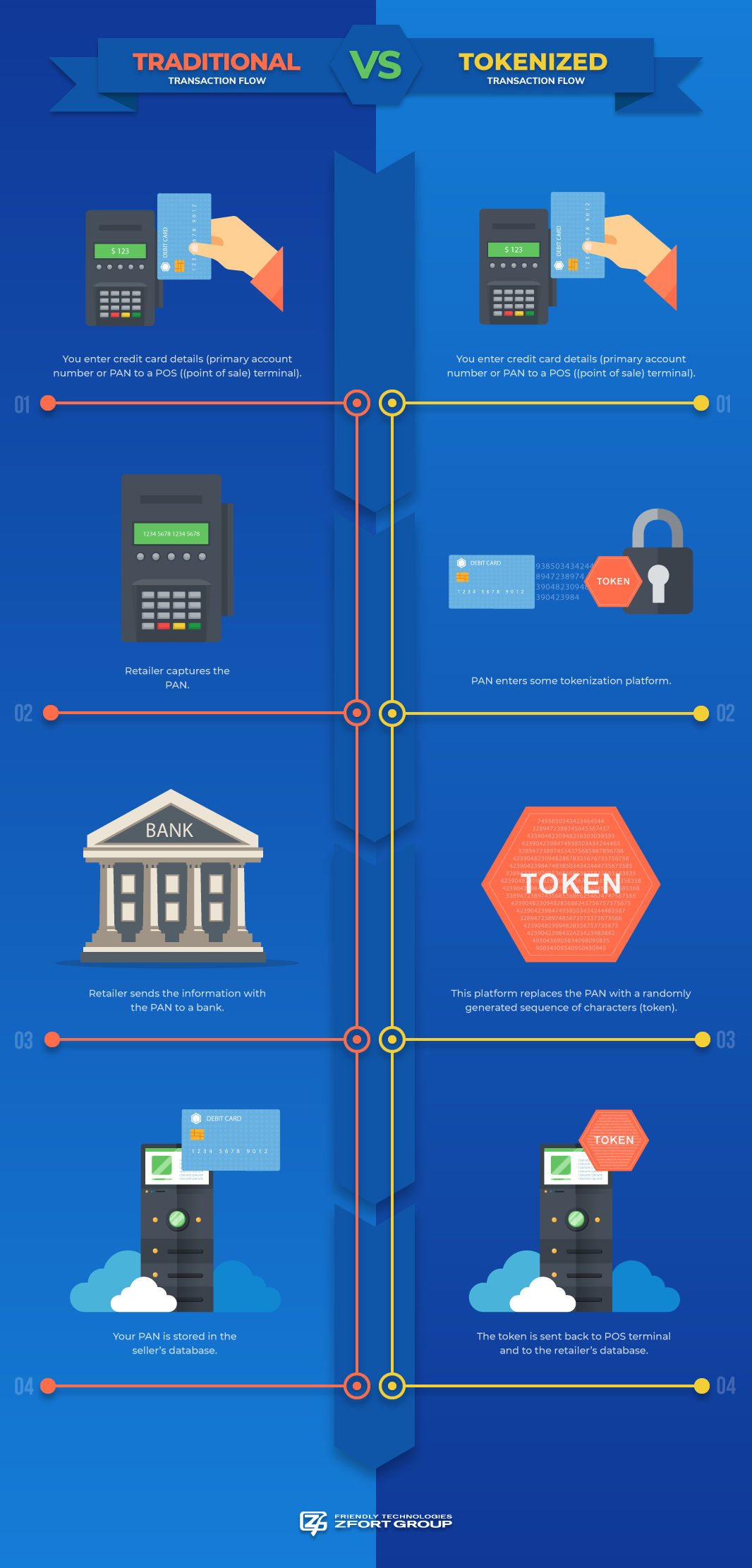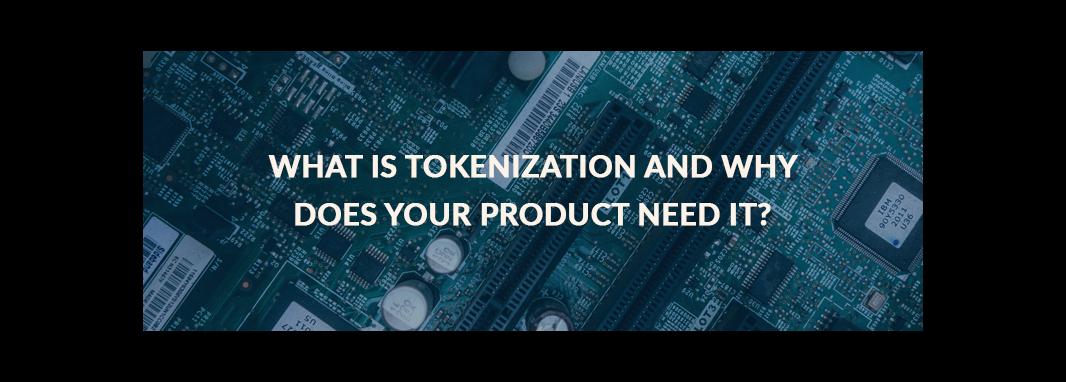While real-world assets become more on the planet, the merchants want to take them to the market. Since not every asset can be moved or sent out, the traders create actives or shares for them. Yet, the thing is that it leads to unnecessary and time-consuming paperwork along with an engagement of middlemen. Sounds insecure, doesn’t it?
Tokenization is a revolutionary process which allows avoiding such kind of issues. It lets the merchants sell their products in prompter way and protect the transactions.
In 2008, a Bitcoin creator Satoshi Nakamoto has established an innovative technology called Blockchain based on the distributed ledger technology (DLT). In a word, it is a decentralized database which consists of blocks of data (which actually gave the name to the technology) and is preserved on many different PCs all over the world. First of all, it should have resolved the issue of cryptocurrency double-spending. And only in 2014, its functionality has been extended to supporting an idea of smart contracts contributing to secure the deals.
While smart contracts exclude the mediators in the transactions, blocks in a blockchain encrypt the data making it indestructible. With that being said, any attempt to break the blocks can be noticed by any member of the network and prevented. Thus, processing the bargains through blockchain system results in automated and secure operations without a third party.
Everything You Wanted To Know About Tokenization
Tokenization And Tokens
First things first, so let’s start with the original meaning of tokenization. It is a technology that replaces the value stored in a specific object to a digital token. The last one can be managed within a blockchain system.
Would you like to get a real-life example in retail industry?
Well, how often do you shop online? When was the last time you paid with a credit card? Have you ever thought of how safe your credit card information is and how it can be stolen?
Let’s explore the traditional vs tokenized transaction flow when using credit card processing.

By tokenizing your payment information it is impossible to access sensitive credit card data which makes all transactions safe. You can take a closer look at the tokenization platform developed by our blockchain specialists recently and get a better idea of how it can be used.
Assets Tokenization
When it comes to Blockchain trends in 2018, tokenization is one of them. Let’s forget what we’ve been previously talking about and look at tokenization from a different angle.
Let’s say you have an asset and want to sell it fast and securely. Tokenization may transform your asset into a token and then move it, record, or store on the digital ledger system. Except for the assets, you have a chance to tokenize the services you offer and the funds you have.
How Can You Benefit From Tokenization?
Let’s imagine you have an asset and it’s challenging to transfer it to your customer. You know the data can be stolen at any point in the delivery chain, or the transfer process will require too many digital resources.
Your customer doesn’t want to take risks as well. In this case, tokens presenting the real assets are aimed to help you and your customer to resolve the issue. While tokenization occurs right on the Blockchain system, you don’t have to worry about security and transparency of a transaction.
While the whole world is discussing the prospects of transferring the assets into the token, some of the most progressive companies try to reach the next technological stages. In spring 2018, they’ve launched Atlant project working in real estate. Additionally, BankEX project has also launched their platform for a financial industry. They allow tokenizing your assets and conducting transactions with no risk of information loss.
Security Matter In Asset Tokenization
With no doubt, tokenization is one of the most reliable ways to protect payment and private data. Except for data security, the process of tokenization enables protecting your goods, services, or even intellectual property like patents, custom designs etc.
When it comes to protecting credit card numbers, SSN, and any other data that can get under threat of hackers attack, people choose tokenization. Even if the intruders steal tokens, it will be impossible for them to extract any sensitive information from them.
While tokenizing the assets, you may use smart contracts. This is a self-regulating code written to a blockchain. It allows its users to exchange the assets without the participation of the third parties. The contract usually spells out all the terms of the deal. In case the participants meet the conditions, the contract automatically comes into action. Making use of a smart-contract you don’t have to gather documents and go through all circles of hell called bureaucracy. The integration of crypto payments into smart contracts further streamlines the transaction process, allowing for seamless and secure exchanges of tokenized assets. Among the participants, there are only you, a buyer, and a decentralized computer algorithm.
The assets tokenization and smart contracts not only protect your payment and private data. They also contribute to a transaction transparency, avoid additional costs excluding intermediaries, save you much time etc.
Find Out If Your Assets Can Be Tokenized
Because the number of assets accessible for tokenization is almost unlimited, experts have divided them into three categories. Thus, we can talk about intangible, fungible, and non-fungible assets. Further, let's cover the details of all categories so that you can understand if your asset can be tokenized.
Intangibles
Intangible assets don’t exist as material goods, yet, they are just perfect for the world of the blockchain.
They can refer to license on specific inventions, trademarks, loan contracts, copyrights, franchises etc. Funds and assets without a material shell are easy to tokenize on the digital ledger system. One can set a unique ID to such kind of assets and then trade them on the market.
Even though the intangibles don’t physically exist, they are still legitimate. Furthermore, they don’t require storage or physical movement. Thus, you can easily get an intangible asset including a unique signature for a token.
Let’s imagine that you’ve previously got an order to create a design for a specific web product. The ordering is ready and you want to send it to a client. Yet, you both live in different countries with different copyright regulation systems. Besides, some issues may occur while transferring money. Furthermore, the commission may be excessive. The paperwork is about to make the transaction almost impossible. This is the case when tokenization can help you.
All you have to do is just agree on the price with your client and set it to a smart contract. The algorithm will assign a unique hashcode to an asset which will guarantee that it is a real patent, not just a copy. By tokenizing intangibles, you contribute to an instant and verified bargains.
Fungible Assets
Fungible items are the ones that can be exchanged for identical items or goods with equal values. Fungible assets can be found in the raw materials sector and are supported by a physical resource. These are interchangeable goods like gold, water, oil, wheat after all.
Any fungible asset can be sold between two participants by means of a smart contract. Excluding the mediators in this process, the trade is registered on a digital ledger system generating a receipt. With that being said, tokenization of fungible goods allows eliminating paper accounting system and exchanging the items on the more comprehensive scale.
Non-fungible Assets
Non-fungible assets usually include artworks, antiques, real estate etc.
When it comes to a tokenization of these assets, the system can transform them into so-called actives which can be further bought and traded. During the tokenization, the owner of an asset receives a digital signature without a chance to change it. The token is a not a copy of your artwork, yet it can be divided into sub-tokens, each with a digital signature. That being said, the actives can be traded between a huge number of people.
Tokenization enables a more protected way of transferring client data and prevents your business from a data loss. It also helps you avoid the paperwork, participation of third-party agents, and additional costs.
How You Can Get Started With Tokenization
If you want to have your tangible asset tokenized, you can try Blockchain platforms such as BankEX, LaToken, or Maecenas. Such platforms imply the independent assets tokenization. This means that you have to handle the creation of a smart contract on your own. In case you make a mistake, you will not be able to change the designated conditions. This option is best suited for those practicing various operations on Blockchain system.
If you don’t want to handle it on your own, yet want to entrust it to professionals, apply to Zfort Group and get an assistance with creating smart-contracts for your upcoming transactions. Zfort is a reliable company which guarantees a personalized approach and high-class end result. Selecting a trustworthy provider who can install tokenization into transaction processes you contribute to reducing risks and improving payment security. Besides, the professional assistance will definitely save you much time and ensure a high efficiency for your business.




